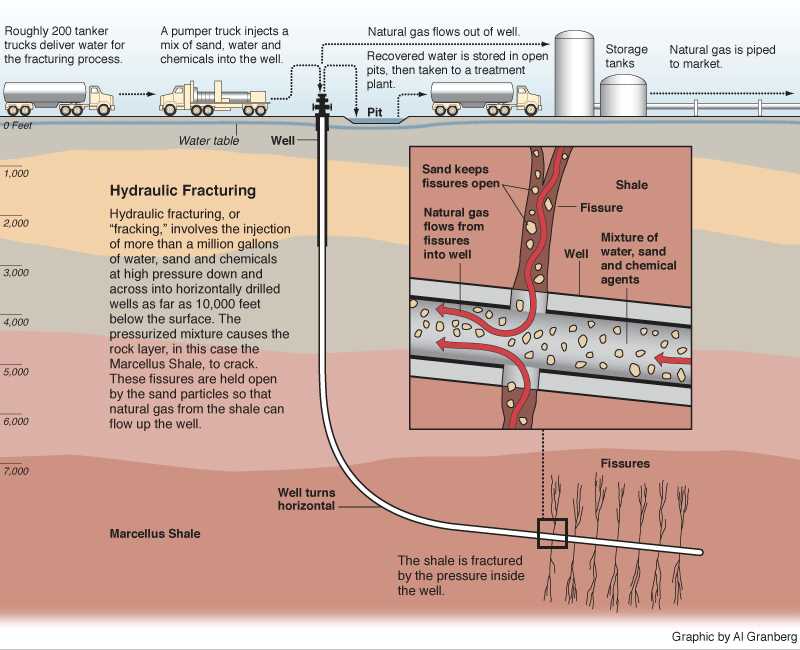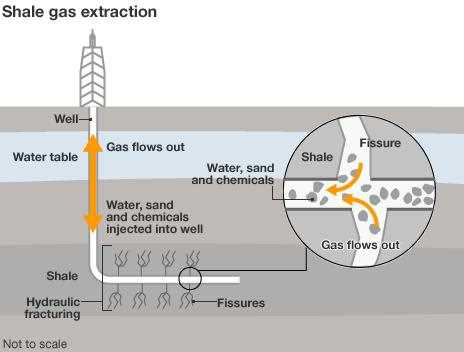What is Hydraulic Fracturing and How Does it Work?
The process of hydraulic fracturing begins with the drilling of a wellbore, which can extend thousands of feet below the surface. Once the wellbore is drilled, steel casing is inserted and cemented in place to prevent any leakage of fluids into the surrounding groundwater. Then, a perforating gun is used to create small holes in the casing and the surrounding rock formation.
Once the fracking fluid is ready, it is pumped into the wellbore at high pressure. The pressure causes the rock formation to crack and create fractures, which extend outwards from the wellbore. The proppant in the fluid fills these fractures, preventing them from closing and allowing the gas or oil to flow to the surface.
After the fracking process is complete, the well is typically put into production, and the gas or oil is extracted through the wellhead. The extracted gas or oil is then transported to processing facilities for further treatment and distribution.
Benefits of Hydraulic Fracturing
Hydraulic fracturing has revolutionized the oil and gas industry by unlocking vast reserves of natural gas and oil that were previously inaccessible. This has led to increased energy production, reduced dependence on foreign oil, and lower energy costs for consumers.
In addition, hydraulic fracturing has created jobs and stimulated economic growth in many regions. The industry has provided employment opportunities for thousands of people, including engineers, technicians, and construction workers. It has also generated revenue for local communities through taxes and royalties.
Environmental Concerns

Another environmental concern is the disposal of wastewater produced during the fracking process. This wastewater contains not only the chemicals used in the fluid, but also naturally occurring radioactive materials and heavy metals. If not properly treated and disposed of, it can pose a risk to the environment and human health.
There are also concerns about the impact of hydraulic fracturing on air quality. The release of volatile organic compounds (VOCs) and other pollutants during the drilling and extraction process can contribute to air pollution and have negative health effects on nearby communities.
Regulatory measures and best practices have been put in place to address these environmental concerns and ensure the safe and responsible use of hydraulic fracturing. However, ongoing research and monitoring are necessary to fully understand and mitigate the potential risks associated with this extraction method.
| Pros | Cons |
|---|---|
| Increased energy production | Potential groundwater contamination |
| Reduced dependence on foreign oil | Disposal of wastewater |
| Lower energy costs | Air pollution |
| Job creation | Environmental concerns |
| Economic growth |
Exploring the History of Hydraulic Fracturing

The Early Years
The origins of hydraulic fracturing can be traced back to the 1940s when it was first used as a method to stimulate oil and gas production. The technique involved injecting water and sand into wells at high pressure to create fractures in the rock formations, allowing oil and gas to flow more freely.
During the early years, hydraulic fracturing was primarily used in conventional oil and gas wells. It was a relatively small-scale operation and did not attract much attention or controversy.
The Shale Gas Revolution
It wasn’t until the early 2000s that hydraulic fracturing gained widespread attention with the emergence of the shale gas revolution. Technological advancements, such as horizontal drilling, made it possible to extract natural gas from shale formations on a large scale.
This development led to a significant increase in hydraulic fracturing operations across the United States and other parts of the world. The combination of hydraulic fracturing and horizontal drilling allowed access to vast reserves of natural gas that were previously considered uneconomical to extract.
Controversies and Concerns
As hydraulic fracturing operations expanded, so did the controversies and concerns surrounding the practice. One of the main concerns is the potential for groundwater contamination. Critics argue that the chemicals used in the fracking fluid can migrate into underground water sources, posing a risk to human health and the environment.
Another concern is the disposal of wastewater generated during the fracking process. This wastewater contains not only the chemicals used in the fracking fluid but also naturally occurring radioactive materials and high levels of salt. Improper disposal of this wastewater can contaminate surface water and soil.
Additionally, there are concerns about the release of methane, a potent greenhouse gas, during the extraction and transportation of natural gas. Methane emissions contribute to climate change and air pollution.
Regulations and Mitigation Measures
In response to these concerns, governments and regulatory bodies have implemented regulations and mitigation measures to address the potential risks associated with hydraulic fracturing. These measures include the disclosure of chemicals used in the fracking fluid, the monitoring of groundwater quality, and the implementation of wastewater treatment and disposal protocols.
However, the effectiveness of these regulations and mitigation measures is still a subject of debate. Critics argue that they are not stringent enough to adequately protect the environment and human health, while proponents believe that they strike a balance between economic development and environmental protection.
The Origins of Hydraulic Fracturing
The concept of hydraulic fracturing involves injecting a mixture of water, sand, and chemicals into a wellbore at high pressure. This creates fractures in the rock formation, allowing for the release of trapped hydrocarbons. The process of hydraulic fracturing has evolved over time, with advancements in technology and engineering making it more efficient and effective.
The early days of hydraulic fracturing were marked by experimentation and trial and error. Engineers and geologists worked together to develop techniques that would maximize the extraction of oil and gas from underground reservoirs. The first commercial hydraulic fracturing operation took place in 1947 in Kansas, USA.
Despite the controversy, hydraulic fracturing continued to expand, driven by the increasing demand for energy and the economic benefits associated with extracting oil and gas from shale formations. The technique has been instrumental in unlocking vast reserves of natural gas and oil, transforming the energy landscape and making the United States a leading producer.
Today, hydraulic fracturing is a widely used technique in the oil and gas industry, with operations taking place around the world. It has revolutionized the energy sector, providing access to previously untapped resources and contributing to global energy security. However, the debate over its environmental and health impacts continues, highlighting the need for ongoing research and regulation.
| Pros | Cons |
|---|---|
| Increased energy production | Potential environmental and health impacts |
| Economic benefits | Contamination of groundwater |
| Access to previously untapped resources | Disposal of wastewater |
| Contribution to global energy security | Potential for induced seismic activity |
Examining the Controversy
One of the main points of contention surrounding hydraulic fracturing is its potential to contaminate groundwater. Critics argue that the chemicals used in the fracking fluid can seep into underground water sources, posing a risk to both human health and the environment. Proponents of fracking, on the other hand, claim that the industry has implemented strict regulations and safety measures to prevent such contamination.
Another area of controversy is the release of methane gas during the fracking process. Methane is a potent greenhouse gas that contributes to climate change. Opponents of fracking argue that the leakage of methane during drilling and extraction outweighs the benefits of natural gas as a cleaner alternative to coal. However, supporters of fracking argue that the industry has made significant advancements in reducing methane emissions and that natural gas can play a crucial role in transitioning to a low-carbon economy.
Furthermore, concerns have been raised about the potential for seismic activity induced by hydraulic fracturing. Some studies have linked fracking to increased earthquake activity in certain regions. Critics argue that these earthquakes can cause damage to infrastructure and pose a risk to public safety. Proponents of fracking, on the other hand, claim that the seismic activity associated with fracking is minimal and can be mitigated through proper monitoring and regulation.
The economic impacts of hydraulic fracturing are also a subject of debate. Proponents argue that fracking has led to a boom in domestic energy production, creating jobs and boosting local economies. Critics, however, point out that the industry is highly volatile and can lead to economic instability in regions heavily dependent on oil and gas extraction.
The Environmental Impact of Hydraulic Fracturing
Water Contamination
Studies have shown that fracking fluids and wastewater can contain harmful substances such as heavy metals, radioactive materials, and volatile organic compounds. If not properly managed, these contaminants can find their way into nearby water sources, potentially contaminating both surface water and underground aquifers.
Air Pollution
Another significant environmental concern associated with hydraulic fracturing is air pollution. The extraction process releases various air pollutants, including volatile organic compounds, methane, and hazardous air pollutants. These pollutants can contribute to the formation of smog and can have detrimental effects on human health.
Methane, a potent greenhouse gas, is of particular concern. It has a much higher global warming potential than carbon dioxide, and leaks during the extraction and transportation of natural gas can significantly contribute to climate change.
Earthquakes
Hydraulic fracturing has also been linked to an increase in seismic activity. The injection of fluids into the ground can create pressure that can trigger earthquakes, especially in areas where fault lines exist. While most induced earthquakes are relatively small, there have been instances of larger, more damaging earthquakes associated with fracking operations.
Habitat Destruction
The infrastructure required for hydraulic fracturing, such as well pads, access roads, and pipelines, can result in habitat destruction and fragmentation. This can have significant impacts on local ecosystems, including the displacement of wildlife, loss of biodiversity, and disruption of natural processes.
Regulatory Challenges
Addressing the environmental impacts of hydraulic fracturing is challenging due to the complex regulatory landscape. The industry is subject to a patchwork of regulations at the federal, state, and local levels, which can vary significantly. This can lead to gaps in oversight and enforcement, making it difficult to ensure that proper safeguards are in place to protect the environment.
[OIL catname]
Fracking has been used for decades as a means to increase the production of oil and gas. However, it has also sparked a great deal of controversy due to its potential environmental impacts. Critics argue that fracking can contaminate groundwater, release harmful chemicals into the air, and contribute to climate change.
The Environmental Impact of Hydraulic Fracturing
Furthermore, the process of fracking requires large amounts of water. This can put strain on local water supplies, particularly in areas where water resources are already limited. The extraction of water for fracking can also have negative impacts on aquatic ecosystems, as it can deplete water sources and disrupt the natural flow of rivers and streams.

Emily Bibb simplifies finance through bestselling books and articles, bridging complex concepts for everyday understanding. Engaging audiences via social media, she shares insights for financial success. Active in seminars and philanthropy, Bibb aims to create a more financially informed society, driven by her passion for empowering others.
